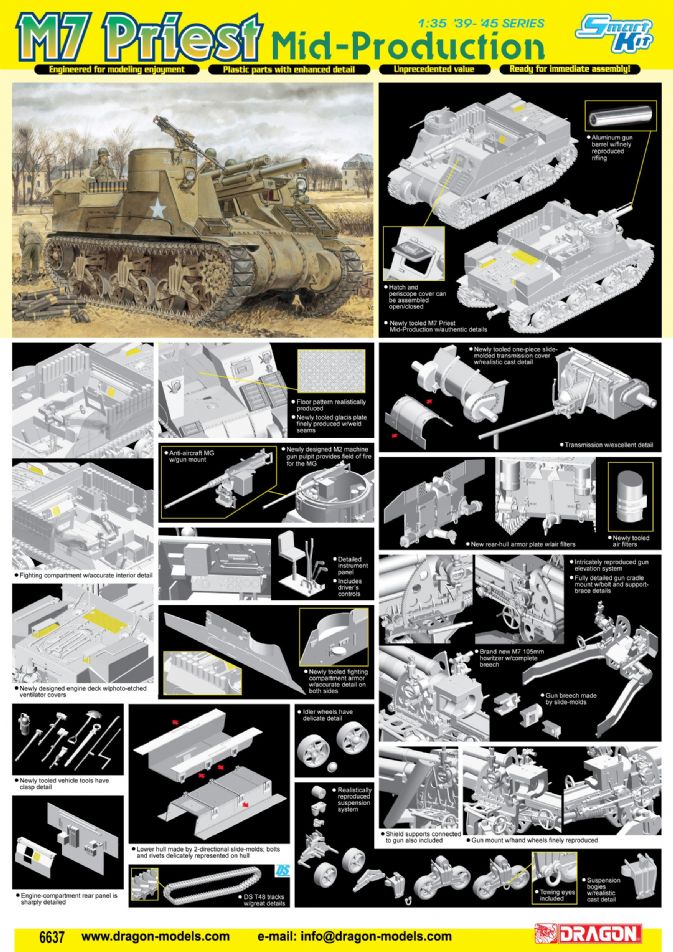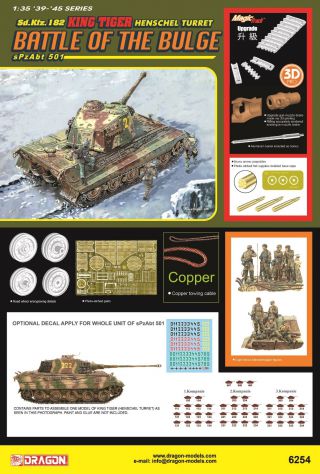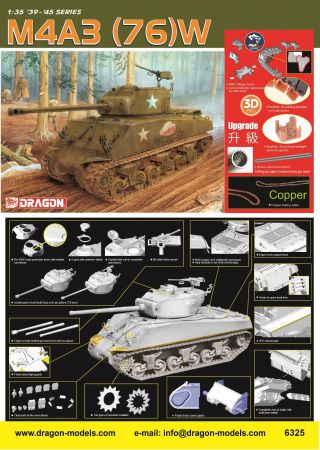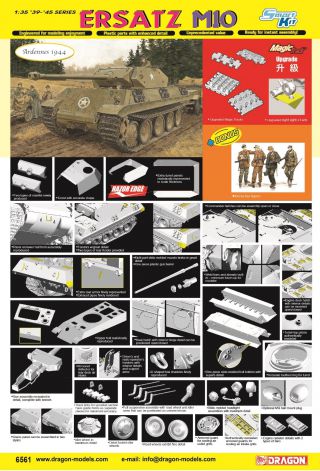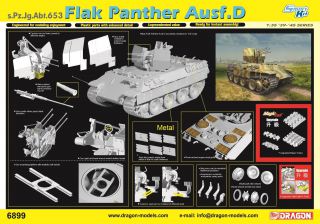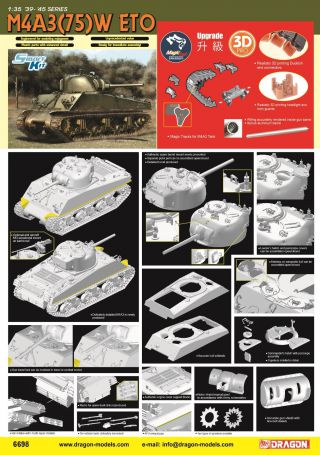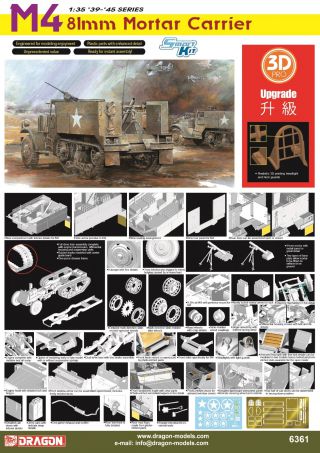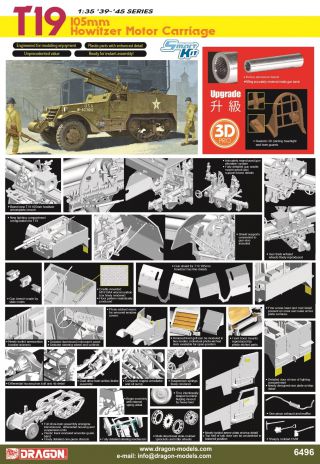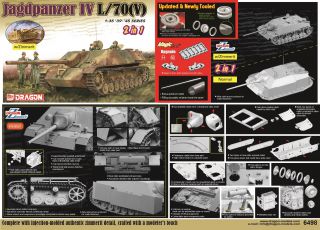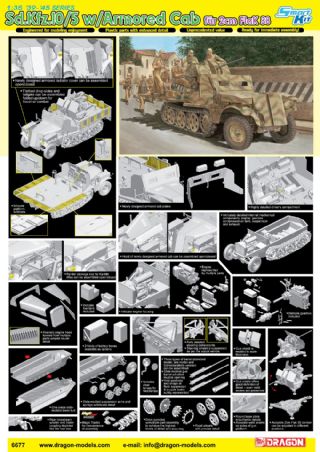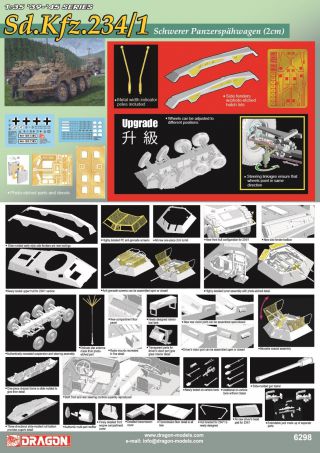HOME → Dragon Plastic Model Kits → 1/35 WWII Military → 6637










Barcode: 0 89195 86637 0
Case Pack: 20 Pieces per case
Box Size: 9.8" x 15" x 3.1"
Feature:
- Newly tooled M7 Priest Mid-Production w/authentic details
- Newly tooled one-piece slide-molded transmission cover w/realistic cast detail
- Newly tooled air filters
- Newly tooled glacis plate finely produced w/weld seams
- Newly tooled fighting compartment armor w/accurate detail on both sides
- Newly tooled vehicle tools have clasp detail
- New rear-hull armor plate w/air filters
- Brand new M7 105mm howitzer w/complete breech
- Newly designed engine deck w/photo-etched ventilator covers
- Newly designed M7 machine gun pulpit provides 360� field of fire for the MG
- Hatches and periscope cover can be assembled open/closed
- Aluminum gun barrel w/finely reproduced rifling
- Transmission system w/excellent detail
- Intricately reproduced gun elevation system
- Fully detailed gun cradle mount w/bolt and support-brace details
- Gun breech made by slide-molds
- Shield supports connected to gun also included
- Gun trails w/hand wheels finely reproduced
- Fighting compartment w/accurate interior detail
- Floor pattern realistically produced
- Anti-aircraft MG w/gun mount
- Detailed instrument panel
- Includes driver's controls
- Engine-compartment rear panel is sharply detailed
- Chassis made by 2-directional slide-molds; bolts and rivets delicately represented
on hull
- Idler wheels have delicate detail
- Realistically reproduced suspension system
- Towing eyes included
- Suspension bogies w/realistic cast detail
- DS T48 tracks w/great details
In the new era of modern mobile armored warfare, the USA recognized the need for a self-propelled howitzer that could keep pace with tanks and lend rapid fire support. Out of the quest for such a vehicle, the American M7 Priest was born. Originally based on the chassis of the M3 Lee tank, the Priest received its name owing to the distinctive pulpit-like mount for the machinegun. A 105mm howitzer was fitted in the open-topped superstructure, and production of the new weapon commenced in the USA in April 1942. Priests began equipping the US Army, but some were also diverted to the British Army which was fighting in North Africa at that early stage. The Priest served with the US Army throughout the war. In all, 3490 Priests were produced, and such was their success that they served in US and other Allied armies well after WWII had concluded.
Dragon has served fans of German self-propelled howitzers well, and now it’s the turn of Allied proponents to add artillery pieces to their collections! In fact, this new kit of a Mid-Production variant of the M7 Priest is something of a milestone since it is Dragon’s first ever open-topped Allied AFV with interior detail. This obviously required completely new designs and tooling for the upper hull and fighting compartment. All the necessary details such as ammo storage are present in the fighting compartment, which itself features finely honed walls to give a true-to-scale thickness to the upper-hull armor plates. The gun is highly detailed and is based on the successful towed 105mm howitzer previously released by Dragon. Interestingly, the lower hull is also a brand new tooling, having nothing in common with existing Sherman kits in Dragon’s range. When combined with the existing high standard of Sherman tracks and running gear, this M7 Priest is most definitely the most accurate version of this artillery piece available on the market.
Reviews:
DML 1/35 M7 Priest - Mid Production - Smart Kit
Date of Review: July 2010
Kit Number: 6637
Primary Media: 284 parts (260 in grey styrene, 10 clear styrene, 4 etched brass,
1 twisted steel wire, 1 turned aluminum)
Pros: Very nicely done new mold kit of this vehicle using only selected sprues
from other DML products; excellent 105mm howitzer
Cons: Few noted other than selection of T48 track may limit options (see text);
fixed ammunition stowage limits options
Skill Level: Experienced
The Kit
During WWII there were four iconic open-topped self-propelled guns used by the major powers: the German 15 cm "Hummel", the Canadian-designed "Sexton" with a 25-lb gun, the Soviet SU-76M, and the American M7 150mm HMC “Priest.” The latter three were excellent designs and went on to live long after the war, all three serving into the early 1960s with various second- and third-world armies. Two of them, the Sexton and the M7, were based on the reliable US M3 medium tank chassis.
The M7 came about due to a perceived need for self-propelled armored artillery weapons to keep up with armored divisions. After a number of prototypes were tested, the M7 entered service and full-scale production in April 1942. While it was based on the M3 chassis, it also absorbed many of the changes that came about due to the introduction of the M4 series medium tanks and reflected those changes as production proceeded along. A total of 2,814 were built as well as 826 of the later M7B1, which used the M4A3 tank's Ford GAA engine in place of the original’s radial air-cooled engine. Roughly one-quarter of these vehicles served with the Allied forces, going to the British and Canadians (and later replaced by the Sexton, which carried the preferred 25-lb gun in place of the American M2 105mm howitzer) and the Free French forces as well as postwar MAP deliveries to many other countries.
Italeri came out with a kit of a late production M7 that had been modified for Military Assistance Program use in the early 1950s, and while a nice kit for its time, suffered from being both a very late production vehicle and their quirky M4 suspension and T51 tracks. When Academy promised a new kit, it was to be based on their new M3 Lee kit, But when that was noted to have some serious problems, it was held up for a number of revisions. What they eventually produced was a mid-production M7 with a riveted hull, T51 tracks and some of the MWO changes that went with it to include the increased ammunition stowage racks which appeared about the time of the Operation Husky landings in Sicily, based on combat operations in North Africa. It has the production three-section bolted transmission housing with the full-size E4151 right side housing section vice the E1230 used on very early production vehicles and taken straight from the M3 medium tank, top-opening stowage bins on the rear deck vice the side-opening ones from the early production series but not the mesh baskets which appeared on top of them or vents which are seen on late production vehicles. It also has the early model shallow “pulpit” for the .50 caliber machine gun.
But that kit suffered from a number of detail problems and missing details such as the engine deck venting, clumsily executed ammo storage, and some problems with the gun itself.
Needless to say, when DML began releasing new mold kits of both the early model M4 Sherman tanks with the early (“M3") type bogie units with integral return rollers and then an excellent M2A1 105mm howitzer, it was only a matter of time before they too issued a kit of this popular subject.
While they are focusing on the same model – the mid-production version of the M7 or “Priest” – the results are much cleaner and closer to the prototype. In this case they have produced a mid-production vehicle with some of the MWO upgrades applied such as the raised AA MG “pulpit” and the folding side shields and increased ammunition stowage. The model has the early model bogies with five spoked welded wheels and six-spoke idlers, machined drivers, and T48 rubber chevron tracks. The additional air vents are present on the engine deck as are the covers that go over the top of those vents. Grouser bins with grousers molded in place are provided as is an interior of all visible components. The kit also comes with the current generation of DML’s take on the M2HB machine gun. Top bows are provided but only in their stowed positions.
DML did skimp on some items. For example, the ammo racks come filled less four rounds on the right and six on the left; while more to scale than the Academy ones and with at least the dividers in place there are no separate ammo rounds or shell casings provided. All of the engine deck vents are solid with the brass grille work simply mounting over them, but as little can be seen through the original even from a few feet away this may not be bad other than making their installation more difficult to accomplish in a clean manner. The engine access doors are molded closed and the auxiliary air vents are also solid. However, it does come with the earlier “round” air cleaners.
The T48 tracks are a good set and represent their prototype well, but photos show them as more common to the later production vehicles and the M7B1 and M7B2 variants. A better choice for “all around” use would have been the T51 irreversible rubber shoe track (which DML also makes as a DS product).
The lower hull is a new mold for this kit and includes the mounts and baffles found in the Priest. The transmission cover replicates the same version as the Academy kit but is cleaner and has a more realistic cast texture. The driver’s instrument panel is the long narrow type. The interior is fairly complete as the upper hull is molded in flat components and as such has inner and outer details on the fighting compartment section.
Stowage bins are the non-vented top-opening type and no stowage basket for mounting on top of the bins are provided.
The M2A1 howitzer is provided verbatim to include the turned aluminum forward section and in this case is missing the shield Steve Zaloga noted was a later addition. A complete new lower carriage and the original travel lock for the weapon (which interfered with access to internal hull ammo stowage) is also provided. Three grouser bins are provided but the grousers are molded in place.
Technical support for this kit is listed as the H3 Design Office.
Three sets of markings are provided, all for solid olive drab vehicles: Battery A, 73rd Armored Field Artillery Battalion, 9th Armored Division, Germany 1945 (gun A10); Battery A, 231st Armored Field Artillery Battalion, 6th Armored Division, Germany 1944 (“All American/Crazy Helen”, no bumper code); and Battery A, 399th Armored Field Artillery Battalion, 8th Armored Division, Bohemia 1945 (“Minnesota”, gun A2). A set of Cartograf decals are provided and include yellow warning stripes for the ammo shipping canisters.
Overall, this is a much better kit than the unfortunate Academy kit and offers a solid base for conversions to either early production or late production kits to modelers with a deep Sherman/Grant/Lee parts box. I do wish it had come with the markings for either the 54th, 67th or 391st Armored Field Artillery Battalions (3rd US Armored Division)!
- Cookie Sewell
DML 6637: M7 Priest Mid Production
1/35 injection plastic kit with decals, metal barrel and photo etch
Commonly known as the Priest, the M7 Howitzer Motor Carriage (HMC), formed the backbone of the US armoured division’s self-propelled artillery. Recognising that the likelihood of becoming involved in World War II was very real, the American Army saw a need for fully tracked self-propelled artillery that could keep up with the tanks. This lead to the mounting of a 105mm howitzer on the chassis of the M3 medium tank in 1942. Over time the M7 HMC underwent changes to increase the ammunition storage and update the chassis for changes introduced on the M4 Sherman. The M7 HMC proved successful and continued to serve in several armies after WWII including in the Korean War. The British officially called it, the Priest, which reflected that the machine gun ring resembled and pulpit and the British practice of naming self-propelled guns after the titles of church officials.
OVERVIEW
This 2010 Dragon release is in the Smart Kit format and is Dragon’s first model of the M7 HMC/Priest. The kit depicts a mid production vehicle typically of many used in Western Europe in WWII. As a new subject, it has numerous new parts including the hull, superstructure, open fighting compartment, and many small fittings such as air filters, and spare track racks. The kit contains a 105mm howitzer with metal barrel and new lower cradle. Photo etch is provided for four mesh screens while other small detail is captured using modern moulding techniques. The gatefold instructions have 12 steps of line drawings.
NEW ARMOR & FIGHTING COMPARTMENT
The Priest has new tooling for the armoured body and fighting compartment which capture fine detail such as weld marks and internal bracket bases. The upper side plates are large parts with detail on both faces and the right site has the base of the MG ‘pulpit’ integrated into which results in a neat appearance. The hinged upper side flaps are separate pieces which will be useful for dioramas or displaying the kit to show off the internal detail.
The engine deck is based on a slide molded cover with separate parts for the fitting such as tools, tow cable (made from twisted metal with plastic eyes), flaps, and the PE mesh screens over the vents. The tools have integrated claps and are new to this kit.
On the Priest’s front there are new parts for the transmission cover and glacis plate both of which are to Dragon’s latest standards depicting weld marks and casting detail. Again the kit has separate parts for the relevant small fittings like the lamp guards (clear plastic is provided for the lens), spare tracks (one part per rack to save time and avoid misaligned gaps between links) and flaps. The transmission cover is based on a slide-molded part with separate parts for the ribbed vertical joins and horizontal join to capture the numerous bolts.
The fighting and driver compartment is impressive, and definitely in the Smart Kit format, which from talking to other modellers is very much what people will want in this kit. Features include a single piece floor tub with anti-skid, detailed bulkhead with sharp integrated detail for several fittings and separate parts for the range/cleaning rods, crew seats, driver’s steering and braking levers. The ammunition bins come partly filled with crisply cast cases. The pulpit mounted Browning machine gun is mounted on a multi-part U shaped bracket and has a separate ammunition box. The pulpit’s ring and upper curved armor are separate parts. The inner face of the front armor is detailed and includes the dash board with dials. The driver’s compartment also features the transmission and shaft.
HULL & TRACKS
The one-piece lower hull tub is new and has ample detail on the belly plate. The rear hull plate is also new and includes a pair of sharply defined air filters. The suspension has VVSS bogies (Vertical Volute Spring Suspension) and the road wheels have five spokes with lightening holes (spare parts include solid road wheels and alternative sprockets etc). The tracks are the T48 pattern and are the one-piece Dragon Styrene (DS) type which works well for the M3/M4 series tracks. They are packed flat in the box, so that they do not get bent in storage.
105mm HOWITZER
The M2A1 105mm howitzer comes complete with crisp hand wheels, sights, cog wheel, recuperator, spring and slide molded breech. The howitzer’s cradle has sharply defined bolt heads and captures the H profile of the trails (mounting bars). The howitzer has a drop fit metal barrel with a drilled out muzzle with internal rifling. The gun’s traverse and elevation mechanisms are realistic and feature crisp teeth on the arcs. The gun shield has detail on the inner face and includes the lower plates and the metal mounting rods.
DECALS
The kit includes two Cartograf decal sheets and the painting guide outlines three HMCs which are painted solid olive drab and served with the US Army in WWII.
The first (box art) is gun 10 from 73rd Armored Field Artillery Battalion, 9th Armored Division in Germany 1945. The second is from the 231st Armored Field Artillery Battalion, 6th Armored Division in Germany 1944 and has white markings “All American” and Crazy Helen”. The last is from 399th Armored Field Artillery Battalion, 8th Armored Division in Bohemia (Czech Republic) in 1945 and is named “Minnesota”.
One decal sheet contains the markings unique to this kit (flags, stars in several sizes, yellow warning stripes for the ammunition canisters etc) while the other contains generic white tactical and registration markings.
RECOMMENDATION
Dragon’s new M7 Priest will certainly please the many modellers who have been anticipating its release. The kit is designed to the latest standards and is the best available model of the Priest in 1/35. The kit will make an impressive model out of the box while also providing a solid basis for use in dioramas or super detailing. Highly recommended.
- Neville Lord
Kit, DML 6637, M7 Priest Mid Production
DRAGON MODELS LIMITED
Product Specifications.
6637, M7 Priest Mid Production Smart Kit. 1/35th-scale injection-molded styrene/multimedia kit. Contains: 349 styrene parts, two DS100 flexible styrene track lengths, one etched brass fret, one length of wound metal wire, one turned aluminum gun tube, three decal markings schemes and six pages of instructions in 12 steps.
Introduction.
In deciding to get serious regarding producing kits of M4 Sherman-based kits, DML, over the last few years have released brand-new or heavily re-tooled kits of nearly every variation except for the M4A4. When they recently released a new-tool rendition of the US 105mm howitzer, most modelers knew it would only be a matter of time before an M7 105mm HMC (a.k.a. Priest) would follow. So it has come to pass that DML has released a kit of the mid-production M7 variation, which, on close inspection looks pretty damn good.
Although it is based on Sherman-lineage parts from DMLs stock, the only re-used parts are from the 105mm howitzer kit and the early VVSS suspension system (first seen in the M4A1 DV kits). Naturally, the superstructure and interior bits are all-new, but DML has also provided a new lower hull pan as well as another type of three-piece cast/bolted differential cover.
Readers should note the following: I am using, wherever possible, US ordnance parts numbers to help describe some of the components in this kit. These numbers are found in several of Steve Zalogas books and magazine articles, where he acknowledges Joe De Marco and Richard Hunnicutt as his prime sources regarding M4 esoterica. Any lapses in the interpretation of these numbers are my responsibility.
Tracks.
These are composed of two lengths DS100 material, molded in soft styrene, which can be fixed together using standard styrene cement. They represent T48 rubber chevron types and the detail is typical of tracks molded in this fashion: crisp and accurate. Of note, these tracks also have excellent detail on their sides, with the end connectors and track pins sharply portrayed; this makes them a rival to any individual link tracks on the market in the detail department. And, they are far more quickly assembled. The modeler is advised to ensure that the idler wheel axle (a separate part, which will need to be slightly modified) is doing its job, so the tracks are properly tensioned.
Suspension System.
This is the early D37893 VVSS suspension system, commonly referred to as the M3 type, which was first introduced in DMLs M4A1 DV kits. The read-wheels are the welded D38501 types with five spokes, which feature properly-placed grease nipples and relief valves. The brackets consist of inner and outer halves and there are separate two-part volute springs that go between them, return rollers and two swing arms; after assembly the latter will remain movable. The main parts have fine casting texture, but there are no foundry symbols or numbers present. The parts go together well, but I needed to apply pressure and some super glue when assembling the inner and outer halves of the brackets. Only one pair of drive sprockets, of the open type, is provided. The idler wheels are the welded type with six spokes. The final components for the suspension are the axle spindles for the idler wheels and a mounting plate. It is recommended that the idler wheel axles are not fixed in place until the tracks are fitted. Unlike previous DML M4-based kits, these can not be adjusted to help properly tension the tracks. With a simple modification, they can be made adjustable, which I recommend, so that the tracks can be properly fitted.
Hull.
The new lower hull is provided as a single, slide-molded part and depicts the riveted type. It is not the same part included in earlier M4-based releases (or the most recent iterations, for that matter), since upon close examination, there are some subtle detail differences; also, an entirely new row of rivets and a flange has been added beneath the molded-on sponson floors. It features proper rivet, bolt, panel and rib details, while the escape hatch lid on the belly has been properly deleted. The hull sides also have the mounting plates for the VVSS brackets molded in place. Internally, there are mounting locations for the M7s main floor plate, as well as some molded-on dividers.
Up front, there is a 12-part, E6480 three-piece cast transmission/final drive cover. It is new for this kit and unlike previous DML kit releases, this one has a separate mounting strip with bolts. This is because the upper rim has a deflector lip, not seen on the parts in the M4A1 DV kits. This assembly has subtle casting texture, foundry numbers and drain plug details. The bolted-together flanges used to assemble the cover come as one part per side; in reality, this is a two-part assembly, so the modeler should be careful during clean up, RETAINING the seam for the proper appearance. The final items are separate tow shackles and their mounts.
The hulls rear plate features molded-on engine compartment access door lids, to include a molded-on grab handle. The plate transitions to the hulls belly plate at an angle, rather than as a curve. Other items such as the usual tow shackles and their mounts are given, as well as a two-part trailer hitch. The multi-part carburetor air cleaners represent one variation of the round type. The final items are the exhaust pipes with their fish-tail ends, which is presented as a three-part assembly.
Superstructure.
The basic shape of the superstructure is captured quite well, with subtle weld bead detail and tie-down loops present where appropriate. The side plates are quite thinly-molded and there are no unsightly and difficult to remove knock-out pin marks present anywhere. The side and rear panels around the fighting compartment are of the type with the folding extensions that covered the ammunition stowage bins; these are separate parts and can be depicted raised or lowered. The front plate properly captures the appearance of the curved top section. Separate head-lamp mounts and horn are provided, as are the relatively thin and appropriately-shaped brush guards. The head-lamps are provided with clear lenses. The drivers view-port flap is separate. Unfortunately, the prominent mount that held the stem, which in turn secured the flap in the open position, is molded in place. It is therefore, poorly represented, while the stem itself is molded in its stowed position on the inside face of the view-port flap. Three grouser boxes (representing one known variation) are provided and they are fully stowed with grousers; personally, I would have preferred that they were empty with separate grousers. This would allow the modeler more display options since these boxes were frequently used to stow all manner of things. The spot welds that held them in place are also present on the superstructure part, which is a nice touch. The final items are a filler cap for the area above where the transmission is mounted, as well as separate fenders for each side of the superstructure.
The rear of the superstructure consists of an extension plate on each side and another plate bridging the two. The extensions each have a separate tail-lamp and include fine weld detail. The bridge plate features an opening for the engine starter crank and a separate axe for stowage. The final items in this location are the two mud flaps, one on each side above the idler wheels.
The engine deck part is separate and features crisp bolt and panel details. Three etched brass parts for the screened areas are provided and they fit into recesses on the deck. The forward-most grill covers the engine deck air cooling vent. However, it and the two smaller vents are not opened up, but merely very slightly recessed. The small screens are covered with plates that extend somewhat above the surface, so the fact that they are not open beneath is difficult to see. Not so for the larger air cooling vent, where parts of the engine can easily be seen if it were open. So, the modeler can either accept DMLs design or open things up. If doing the latter, some detail must be added inside.
The tool stowage is well done and these items are all separate parts. There are attempts on some of the tools to depict the straps that held them in place. Some have this treatment and some do not; some only have part of the strap molded in place. I applaud the idea and think that the execution simply needs to be tweaked. Braided metal wire and styrene end loops are given to create a tow cable. The end loops have strap details molded in place as well, but their overall appearance seems to be somewhat undersized. The two stowage boxes appear to be properly-sized and represent the second, top-opening type with no vents on their side and no screened stowage baskets on top. Other items on the deck include several fittings whose purpose is unknown to me, as well as separate fuel filler port caps. While previous DML M4 kits often had detailed openings under the caps, this kit does not. The stowed frames for the fighting compartments canvas foul weather cover are both given as separate parts, as are the hand rails seen on each side of the superstructure plates. The smaller extension rods for the frames are not provided.
Fighting Compartment.
The prominent ammunition racks are partly filled with closed packing tubes; there are several empty cells in each for a more candid appearance. Overall molding is quite fine, with all of the cell walls crisply represented. No extra packing tubes, full semi-fixed rounds or empty shell cases are provided. There are a few small brackets present, some of which are separate and some of which are molded in place. The rear bulkhead has various fittings molded in place, plus several separate stowage items, which I assume are aiming stakes and/or gun tube bore swab staffs. The plate is partially covered by a sheet metal shroud, which features an etched brass part for the screened opening. The opening itself is not actually open, which seems to be an odd engineering decision. I recommend that it be carefully opened, leaving the molded-on rim in place to fit the screen. The floor plate is a separate molding featuring scribed lines representing the ammo bins and other openings, as well as proper tread plate pattern.
The drivers instrument panel well-represents the type compatible with the Wright radial engine. There is a separate floor panel for the driver (with molded on foot pedals), to which a rather simplified two-part seat is added. The drivers prominent hand controls are given as separate parts, which link with the transmission. The transmission itself is made up of multiple parts, but details are missing. Above the driver is situated a stowage box for the gunners sight quadrant. On the opposite side, below the MG pulpit, are parts to represent a tool drawer and part of the .50 cal ammo stowage tray. No ammo boxes are provided for this area and there are separate parts for the racks that stowed the crews personal weapons. They too are empty. A pair of two-part folding seats is given, one for each side of the fighting compartment, as are a pair of fire extinguishers complete with mounting brackets.
The .50 cal. M2 heavy machine-gun is a two-part affair with separate grips; it comes from a slide-mold so is pre-bored. The cradle is molded with the gun, while the pintle is separate. A separate ammo box, a three-part skate rail mount and a separate gun barrel travel lock complete the area. The ring mount is very well-detailed, capturing the look of the original quite nicely; the prominent brace for the mount is also given. Overall, the M2 looks OK, but the cocking handle needs replacing as it is too small.
Howitzer.
The howitzer is mounted on a new base, which in turn fits onto a receptor on the floor plate molding. New I-beams are provided to extend from the mount to the lower hull side walls.
The core of the howitzers tube is slide-molded, and has the recuperator cylinder, recoil cylinder and the main portion of the tube molded as one piece. The tube is completed with a turned aluminum and styrene bore end, a recuperator cylinder cap, a two-part breech ring, and a two-position, two-part breech block. The aluminum bore end has rifling on its inner surface. The two parts representing the recoil sleigh are then added.
The cradle assembly is a five-part affair with a separate front end cap. The latter part is the type seen on the towed howitzer and sometimes on the M7. Most photos of the M7 show an armored cap which is bolted in place; this is not in the kit, but can easily be added using styrene sheet. The equilibrator spring assembly is based on a slide-molded core. It is complimented by a movable bearing spring rod, which ties in to the carriage assembly.
The cradle assembly is then mounted to the carriage and elevation mechanism, which has the proper lighting holes and gear-tooth detail on its quadrants. This item will traverse and also elevate, so be careful with the glue when you assemble it. Separate linkages for both elevation hand-wheels and the single worm-and-rack traverse hand-wheel are given as are the hand-wheels themselves. The M21A1 telescope mount, M12A2 panoramic telescope, M4A1 range quadrant and M23 telescope mount parts are all included, and they compare quite well to TM photos. Note that the M12A2 panoramic telescope should be carefully cut off and returned to its location at an angle, per photos. Many small non-descript parts provide for the final details.
Molding, Fit and Engineering.
Molding is excellent, with fine seam lines and no ejector pins visible after assembly. Fit is generally OK, but I noted some places where things went slightly amiss. The recoil slide has a prominent seam when assembled, so filler and some careful work will be needed in its elimination. The ammo bins will need a slight amount of thinning on the walls that butt up against the superstructure side plates. The breech will also need care in its clean-up. Otherwise, I found fit overall to be excellent.
Instructions.
These are typical for DML and are well drawn. They are relatively brief, since the parts count in this kit is not excessive. There are some glitches: parts B37 and B38 are reversed in the drawings. Part blue A40 is shown being assembled, but has no corresponding part number shown on the instruction sheet. Painting instructions are rather sparse as they dont give information for the colors of the .50 cal. M2, the instrument panel, the ammo stowage tubes, seat pads and other small details.
Accuracy and Details.
There are a small number of omission and detail issues as follows:
Tow cable end-loops are provided, but they appear to be undersized.
According to Hunnicutt, vehicle specs call for, Provision for (3) .45 cal. SMG
M3; according to TM 9-731E**C1, its one M3 and six M1 Carbines. These two denominations
probably represent the evolution of the amount and type of small arms stowed
in specific versions of the M7. Regardless, no small arms are provided by DML,
which I think is partly due to conflicting references.
The very visible mount for the stem that holds open the drivers view-port is
overly simplified. It and the stem should have been separate parts.
I dont understand the wisdom of providing etched brass screens for certain areas,
while leaving the openings beneath them sealed.
Most (but not all) photos of this version of the M7 show what I presume is an
armored shield on the forward end of the cradle. This is not included in the
kit; it would have made a nice option.
The firing lanyard for the howitzer (part blue A16) is only partially represented;
it lacks the pull-cord with its wooden handle.
The tray that held the extra .50 cal. ammo boxes, just forward of the pulpit
is only partially represented; there are no extra ammo boxes in the kit.
The small extension rods that are part of the canvas foul weather cover frames
are not given.
No sand shield mounting strips are provided; however, these were not often seen
on this variant, according to photos.
Decals and Markings Information.
Printed in Italy by Cartograf, the designs are in perfect register, have crisp edges and feature fine color saturation; carrier film is thin, glossy and cut close to the edges. The designs are printed on two separate sheets. One has national insignia and vehicle specific markings, such as the various names seen. The second sheet has generic numbers, an alphabet and armored division triangles. Registration number sequences and unit codes must be pieced together from these designs. In addition, there are thin yellow stripes that are to be used to represent some of the markings on the ammunition stowage tubes. Otherwise, markings are provided for three vehicles, as follows:
A Company, 73rd Armored Field artillery battalion, 9th Armored Division, Germany
1945.
All American/Crazy Helen, A Company, 231st Armored Field artillery battalion,
6th Armored Division, Germany 1944.
Minnesota, A Company, 399th Armored Field artillery battalion, 9th Armored Division,
Bohemia 1945.
All American/Crazy Helen is a later M7 with heavy duty VVSS, vented engine deck stowage boxes with screened baskets on top, sand shield strip and (probably) the single-piece cast differential cover. Thus that set of markings is inappropriate for this kit. I could not find photos to confirm the accuracy of the other two provided schemes.
Conclusion.
Overall, this kit is visually quite accurate, although it falls somewhat short when it comes to some of the smaller details; some design decisions are also a tad perplexing. According to photos, it seems to well-represent the combination of features present on what Zaloga describes as a vehicle produced from January to July of 1943. With a small amount of additional detailing and careful use of references, this kit will build up into the most accurate out-of-the-box rendition of the most widely used US self-propelled artillery piece of the Second World War.
- Frank V. De Sisto
Introduction
The M7 105mm self propelled gun was developed to provide Armoured divisions with mobile artillery. Introduced in 1942, approximately three and a half thousand units were produced which were used extensively throughout all theatres of WWII and beyond including Korea. It was based on the M3 vehicle, mounting the 105mm Howitzer M2 which itself became the most produced artillery piece in the U S WWII arsenal. The distinctive machine gun pulpit ring offset to the right of the vehicle lead to it being christened 'Priest' by its crews and this name has remained.
Both Italeri and Academy have previously provided versions which have met with
mixed reactions from modellers. Dragon now provide us with a Mid-Production
vehicle which hopefully will rectify many of the inaccuracies present in previous
models and provide modellers with a state of the art version of this popular
allied vehicle.
Contents
The kit consists of 10 grey styrene plastic sprues with a separate lower hull tub, one transparent sprue, a turned metal barrel, one piece of braided wire, DS T48 'band' tracks, a sprue of etched metal grills and 2 small Cartograf printed decal sheets. Box art is by Ron Volstead and beautifully represents an M7 'in the field' in olive drab US livery. The instructions are of Dragons line-drawing presentation and whilst these seem to attract criticism from some quarters I personally love them.
The mouldings are crisp and up to Dragon’s usual excellent standard. The casting texture on the bogie units and the transmission cover is finely done, as are the casting numbers.
Construction begins with the bogie units utilizing the 'spoked' wheels correct for a mid production version. I believe the late version often used pressed metal wheels.
It's probably wise of me to point out that the differences between early, mid and late production versions are not entirely clear cut and often confused by in–the-field modifications to individual vehicles. As always check your references!
The drive sprockets are 4-piece constructions and mesh perfectly with the DS styrene one-piece tracks. I appreciate that some modellers will prefer individual link tracks but in my opinion the moulding on these tracks is top-notch and the ease of use is positively joyful. Judicious sanding with a rough nail board will add authentic wear to the rubber pads. The T48 tracks were very common on Priests of this period but many were fitted with other versions. The idler wheels fit to the hull tub and are adjustable so as to tension the track which of course is tight for this vehicle in common with most allied WWII AFV's. The lower hull tub accepts the bogies and transmission cover
The driver's compartment builds conventionally with a very detailed Differential that will unfortunately be largely unseen in the finished model. The driver’s instrument panel appears to be correct for this mid production version sitting flat directly in front of the driver. The Gearshift levers are finely detailed having been excluded on previous kits.
Construction next moves to the 105mm gun that needs to be positioned before further construction of the fighting compartment can take place. Dragon has previously released the 105mm Howitzer M2 A1 which has been well reviewed. The artillery piece builds conventionally and is a quantum step ahead of previous offerings from other manufacturers. The recoil sleigh and elevator mechanisms are all finely rendered.
The main gun tube is moulded in one piece with the barrel being turned aluminium. The sink marks on previous kit versions have required extensive delicate filling and so this build is particularly welcome and straightforward. The breech appears accurate with comparison of references available to me and can be modelled open or closed. The Gun shields are asymmetric and nestle within the front glacis plate of the vehicle. They are particularly well finished with admirably thin walls. Finally the gun assembly is married to the trestle brace struts and the whole gun is attached to the fighting compartment floor. There is a gun-lock that can be fitted in an upright position for travel or left flat on the floor whilst firing.
The front glacis plate and sides can now be addressed. The 3 grouser bins come as one-piece mouldings with integral grousers. Interestingly, to my mind, most wartime pictures show that a variety of other objects were carried within rather than grousers themselves. Most wartime pictures show the drivers observation plate open and though there is no opening strut provided it’s not hard to fashion one. The light-guards which are prominent, are finely moulded though will improve if etched versions are used, though these are not provided. Transparent lenses are provided to finish the lights.
Early Priest versions had cut down sides that exposed the ammunition in the rear bins to shell or other fragments. Pictures often show welded inserts to protect this gap and by the mid production period factory fitted hinge-down inserts were manufactured that this model includes. The hinges are well represented and the protection extends to the rear Compartment where a low plate is provided that wasn’t present on early production versions. Also provided for the vehicle sides are what I presume are tarp frames that were fitted over the open compartment in foul weather.
The most notable feature within the fighting compartment is the ammo bins. Early versions contained space for 12 fibreboard shell cases. These had been increased in number by this version and feature 17 (right) and 19 (left). The fibreboard casings are well represented but do not fill all the compartments which are nicely partitioned. Wartime pictures show, 'bare' shells were kept out and these can be added (as aftermarket items) though there are false shallow floors that may need to be drilled out. Dragon obligingly provides yellow strip decals that can be applied to these fibreboard containers. Most pictures show these yellow markings. Nicely moulded fire extinguishers sit at the base of each ammo box though these don’t come with decals, which is a shame.
A further notable omission is crew weapon holders that pictures show present usually on the right side of the vehicle beneath the pulpit ring. Despite M1 Garand rifles having been included in previous models I understand it was more common for the crew to be issued with M1 carbines. Brackets are provided so if the modeller wishes - he will have to source weapon holders from elsewhere. The 50 cal machine gun mounted on the pulpit is finely represented using slide mould technology. Careful drilling of the barrel cooling holes will bring this moulding up to etched metal standard. The gun mounting and pulpit ring are also finely rendered and the pulpit has the correct Flattening to one side absent on previous models.
The rear bulkhead models the prominent oil cooler in far finer detail then previous offerings and represent a significant improvement. A separate cover fits over the bulkhead which adds depth and perspective. Previous offerings have included this arrangement as a single moulding.
The rear deck layout partly defines the production model and this to my amateur eye is correct for mid-production status. Most criticism of the Academy model related to the depiction of the rear deck. Of note is the presence of lateral linear grills and raised armour plates to protect them. These were absent in early production models but incorporated to deal with and vent build-up of engine fuel fumes. The grills are well presented in etched metal though the raised guards are modelled in styrene. A common practice by modellers to 'hide' this arrangement on past models was to heap the rear deck with stowage. In reality some form of shelf or welded bars was needed to place stowage on to keep these vents clear. The OVM arrangement varied enormously but the layout of tools seems fairly typical. A large grill adjacent to the rear bulkhead completes the layout. Dragon provides a braided length of metal to fashion a tow wire. In truth I never seem to get on with this piece of metal and usually swop for Karaya copper wire which bends far more naturally.
The side lockers are top opening correct for mid-production status, earlier versions offered side openers. Tools sit atop these and in common with those on the rear deck all tool clamps are moulded with no PE alternatives provided.
Finally we turn to the rear hull. The engine access doors are very well represented as are the distinctive fish-tail exhausts. The rather intricately shaped air cleaners are also nicely moulded. These are cylindrical but in my references are more often square shaped. The drop-down armour plate protecting the air cleaners has the correct cut out at its lower border.
Marking options
Three schemes are provided all depicting US vehicles in overall Olive drab. The decal sheet includes individual letters and numbers to allow individual vehicles to be modelled. The reference number present on each pulpit will need to be made up letter by letter, a labour of Love! All vehicles are dated at either 1944 or 1945. Those wishing to build a British or Commonwealth Priest (approximately a quarter of all Priests produced were passed to Britain or Commonwealth) will need to seek decals elsewhere. Bison decals provide some for the Italian campaign.
Conclusion
I am confident that this Dragon M7 Priest provides the accurate version of a Mid-Production machine that modellers have long been waiting for. This is going to be a big seller to all those Allied AFV fans and no doubt many of us will wish that Dragon continue their foray into modelling Allied vehicles. Wartime Priests were typically draped in Stowage and many aftermarket producers most notably Resicast have specific stowage sets that cry out to be mated with this Dragon offering.
- Vinnie Branigan

